
This work is licensed under a Creative Commons Attribution 3.0 Unported License.
Kershnee Sevnarayan and Norman Vaughan
Vol. 39, No. 2, 2024
https://doi.org/10.55667/10.55667/ijede.2024.v39.i2.1341
Abstract: This study used the Community of Inquiry (CoI) framework to provide a collaborative experience for students from marginalised communities in a large enrollment module in South Africa. The CoI framework consists of three elements including the social, cognitive, and teaching presences. This study focused on the teaching presence element, along with the seven principles in the CoI framework, which involve design and organisation, facilitation, and direct instruction. The study context was one large English language application course, which enrols over 1,200 students who speak English as an additional language at an open distance e-learning university in South Africa. The research used a self-study approach, and the course was designed over a few months to accommodate students and create collaboration amongst them. The findings revealed that the course structure engaged students, provided personal introductions and goal-setting opportunities, and incorporated motivational content, which increased student engagement and collaboration. Communication in the course was facilitated through familiar social media channels to provide alternative content modes, which further supported student learning. Direct instruction, which involved explicit assignment support and feedback, was crucial to ensure students achieved the learning outcomes. The findings of this study highlight the significance of the CoI framework and its seven principles to creating a collaborative and engaging learning context in large-enrollment courses.
Keywords: Collaborative learning, community of inquiry framework, distance education, large-enrollment online course, higher education.Collaborative learning, community of inquiry framework, distance education, large-enrollment online course, higher education.

This work is licensed under a Creative Commons Attribution 3.0 Unported License.
Résumé : Cette étude a utilisé le cadre théorique de la Communauté d'Enquête (Community of Inquiry - CoI) pour offrir une expérience collaborative à des étudiants issus de communautés marginalisées dans un module à forte inscription en Afrique du Sud. Ce cadre théorique comprend trois éléments : la présence sociale, la présence cognitive et la présence enseignante. Cette recherche s'est concentrée sur l'élément de présence enseignante ainsi que sur les sept principes du cadre de la communauté d’enquête, qui englobent la conception et l'organisation, la facilitation et l'enseignement direct.
Le contexte de l'étude concernait un grand cours d'application de la langue anglaise, regroupant plus de 1 200 étudiants parlant l'anglais comme langue étrangère, au sein d'une université ouverte d'apprentissage à distance en Afrique du Sud. La recherche a adopté une approche d'auto-étude, et le cours a été conçu sur plusieurs mois afin d'accommoder les étudiants et de favoriser la collaboration entre eux.
Les résultats ont révélé que la structure du cours favorisait l’engagement et la collaboration des étudiants, car elle proposait des introductions personnelles, des choix d'objectifs et intégrait du contenu motivationnel. La communication dans le cours a été facilitée par l’usage de médias sociaux familiers, offrant des modes alternatifs de contenu pour soutenir davantage l'apprentissage des étudiants. L'enseignement direct, incluant un soutien explicite pour les devoirs et un retour d'information, était crucial pour assurer l'atteinte des objectifs d'apprentissage par les étudiants.
Le contexte de l'étude concernait un grand cours d'application de la langue anglaise, regroupant plus de 1 200 étudiants parlant l'anglais comme langue étrangère, au sein d'une université ouverte d'apprentissage à distance en Afrique du Sud. La recherche a adopté une approche d'auto-étude, et le cours a été conçu sur plusieurs mois afin d'accommoder les étudiants et de favoriser la collaboration entre eux.
Les résultats ont révélé que la structure du cours favorisait l’engagement et la collaboration des étudiants, car elle proposait des introductions personnelles, des choix d'objectifs et intégrait du contenu motivationnel. La communication dans le cours a été facilitée par l’usage de médias sociaux familiers, offrant des modes alternatifs de contenu pour soutenir davantage l'apprentissage des étudiants. L'enseignement direct, incluant un soutien explicite pour les devoirs et un retour d'information, était crucial pour assurer l'atteinte des objectifs d'apprentissage par les étudiants.
Les résultats de cette étude mettent en évidence l'importance du cadre de la communauté d’enquête et de ses sept principes pour créer un contexte d'apprentissage collaboratif et engageant dans des cours en ligne à grand effectif.
Mots clés : apprentissage collaboratif, cadre de la communauté d'enquête, enseignement à distance, cours en ligne à grand effectif, enseignement supérieur.
In higher education institutions (HEIs), an active learning classroom has become a key aspect of the broader education strategy, which aims to enhance student collaboration and engagement in the learning process. Consequently, HEIs are increasingly integrating cutting-edge technologies into their pedagogical practices and designing innovative courses to enhance and support the teaching and learning process (Carloni, 2023). Academic achievement is a focal point in HEIs (Rehman et al., 2023) and is pertinent to student retention (Hamman et al., 2021). Research after the COVID-19 pandemic has emphasised that collaborative learning is a highly effective pedagogical instructional strategy (Pavlov et al., 2021; Qureshi et al., 2023). Collaborative learning promotes self-regulation (Vaughan et al., 2023), increases students’ attitudes and motivation to learning (Sevnarayan, 2023), and has a positive influence on students’ academic performance and the learning process.
For Patino et al. (2023, p. 2), “Students must do more than just listen: they must be actively involved in the learning process”. Active learning is associated with socio-cultural models of learning, which intimates that knowledge is constructed when we learn with others (Patino et al., 2023). Active learning is a student-centred approach to learning that usually involves students reading, writing, thinking, and discussing ideas in peer groups, which makes learning meaningful. Meaningful learning is the process of building connections between new and existing knowledge that leads to a deeper understanding and application of knowledge.
According to Prince (2004), collaborative learning is one of the most significant methods of active learning. Collaborative learning has been defined as a pedagogical strategy that emphasises mutual respect, personal responsibility, and active engagement, where students acknowledge their own agency in learning and value the unique perspectives and contributions of their peers (Panitz, 1999). “In collaborative learning situations where social interaction occurs, learners are able to adopt higher level thinking through gaining insights from peers and through instant feedback” (Huang & Lajoie, 2023, p. 2). According to Pavlov et al. (2021, p. 228-229):
While collaboration is key for any successful learning, it is a must for an English as a Foreign Language (EFL) classroom. In contrast to ‘content courses’, in an EFL classroom, which is the focus of our study, the main aim is not to transmit or create subject knowledge, but rather to develop the communicative competence. This includes linguistic competence (in simple terms, knowledge of vocabulary, grammar, pronunciation, and spelling rules), strategic competence (knowledge of communication strategies), socio-cultural and actional competence (aspects of register, politeness, and style, knowledge of language functions and their use), and discourse competence (ability to build cohesive texts). These skills can only be developed when learners become active participants—and collaborate.
A study conducted by Lei and Medwell (2021) in China revealed that student teachers showed positive attitudes towards online collaborative learning, recognised its advantages and features, and developed skills such as autonomy, collaboration, and decision-making. However, student teachers also faced challenges, including difficulties with initial contacts and maintaining group participation, and they relied heavily on their teacher for support and guidance. Similarly, Xing et al. (2023) studied analytics to understand how student engagement influenced collaborative learning. They highlighted that group problem-solving skills boost students’ understanding and act as a bridge between group engagement (both behavioural and social) and individual cognitive comprehension. Furthermore, researchers like Resta and Shonfeld (2013), argue that online collaborative learning improves the interaction between lecturers and students and creates teaching and social presences. While the research indicates that collaboration can decrease the sense of loneliness in distance education contexts (Resta & Shonfeld, 2013) which is pertinent during stressful periods, according to the literature the main source of tension is the ability to collaborate amongst large student groups. This raises the question of how to facilitate collaboration in large online groups, especially in distance education contexts.
According to the ninth annual Changing Landscape of Online Education (CHLOE) report from Quality Matters (2024), roughly three-quarters of the chief learning officers at HEIs in the United States indicated an increasing demand for online options from campus-based students, with 60% noting that online sections typically fill first. Nearly half (46%) of the 324 online learning leaders surveyed added that online program enrollment is outpacing enrollment growth in on-campus programs at their institutions. Due to this increased demand for online learning in HEIs, this article seeks to address a notable gap in the body of research by investigating the potential of collaborative learning in a large enrollment module to enhance students’ learning experiences.
Moore (1989) identifies three types of interaction in a distance education context: student-content, student-instructor, and student-student. It is important to note that these three forms of interaction are not only essential for active learning but also crucial for student engagement. While various factors influence active learning, social interaction is a critical factor that makes collaborative learning a pertinent aspect of online education.
Social media’s potential for facilitating social interaction and collaborative learning is well documented. Prior studies attest that social media platforms are useful for students in HEIs for educational purposes, which makes them a significant tool in online education (Forkosh-Baruch & Hershkovitz, 2012). Social media platforms in online education have transformed the way students learn and interact with one another (Chan et al., 2020; Sevnarayan, 2023). Platforms such as WhatsApp, Telegram, Instagram, TikTok, and Facebook create a vast learning space where students can create meaningful interactions with their peers and lecturers, which creates collaborative learning. Social media platforms extend beyond conventional face-to-face interactions and may promote active participation, feedback, shared learning experiences, accessibility, and inclusivity for all students.
The importance and challenges of providing equitable access to higher education have been well documented in the research literature (Department of Education, 2016; Michalski et al., 2017). This study focuses on how the CoI (Garrison, 2017) framework was applied to a high-enrollment online module (course) in South Africa to provide a meaningful and collaborative learning experience for all students, specifically those from Indigenous and marginalised communities. At the heart of this study is an exploration of how Vaughan et al.’s (2023) seven principles of online and blended learning can be used to design, facilitate, and direct a dynamic and collaborative community that not only enhances student motivation and engagement, but also drives success within the module. The key research objective of this self-study was to explore the impact of a collaborative approach to learning in a high-enrollment online module. This objective serves as a critical benchmark in understanding how the CoI (Garrison, 2017) framework can shape the educational journey of students in an open and distance learning environment. The research question is thus:
The need for universities to improve collaboration and academic achievement through learning methods in education is becoming more urgent. This is evident in the increased body of research on student collaboration and engagement (Carloni, 2023; Hamman et al., 2020; Pavlov et al., 2021; Qureshi et al., 2023; Rehman et al., 2023). Despite the research on student collaboration and engagement, there are still gaps in our knowledge about collaborative learning in courses with a large number of students. This review of existing literature aims to fill these gaps by exploring the application of the CoI framework in courses with high enrollments.
Boulton et al. (2019) employed a survey methodology that targeted first-year and second-year undergraduate students at a United Kingdom university. Participation was encouraged through email invitations, recruitment booths, and prize draws. The survey ran from February to June, 2017 over 10 waves, spanning 19 weeks. The survey measured students’ engagement with 17 different learning activities that included social and academic pursuits which occurred online and offline. A notable gap in the study was observed during the academic term, where engagement increased at the start, dropped off mid-term, and decreased further towards the end. This highlights the importance of sustained engagement throughout the academic term. This was attributed to students’ varying workloads and assessment schedules. Despite a non-significant increase in reported effort, engagement decreased, while happiness surprisingly increased towards the end of term. This trend was linked to students’ anticipation of the end of term, which contradicted individual-level correlations between engagement and wellbeing. Similar student engagement issues throughout an online course were also reported by Pazzaglia et al. (2016).
In a similar vein, Baanqud et al. (2020) conducted a study with 80 post-graduate students from various disciplines at Aden University in Yemen and explored the potential of web-based tools (such as Google Drive and Google Sheets) to facilitate collaborative activities between students. The findings revealed a positive correlation between students’ cognitive engagement and knowledge construction in online web-based spaces. This suggests that technology can play a key role in enhancing collaborative learning. This also suggests that web-based environments encourage student interaction, engagement, and active discussions, which may lead to new understandings and knowledge creation. However, the study's limited context and focus on specific web-based tools create a research gap: the need to investigate additional success factors, such as self-efficacy, and the impact these success factors have on knowledge construction and productivity in other collaborative learning contexts. This study aims to address that gap.
Furthermore, Ige et al. (2023) examined the impact of a student-led, collaborative support initiative in the Faculty of Health Sciences at the University of Cape Town. This study was catalysed by the #FEESMUSTFALL movement in South Africa. Ige et al.’s (2023) study used a mixed-methods approach grounded in transformative design to employ a survey that gauged student satisfaction and desires for enhanced support. The findings indicate a strong preference for informal, peer-driven support structures. This stresses the importance of student involvement in designing support mechanisms. Students mentioned the need for more physical spaces and flexible after-hours assistance. The study reveals a gap in the responsiveness of current support systems to student needs and notes the potential for greater student involvement in designing support mechanisms. This current article addresses this gap and explores how peer-driven initiatives can be scaled and integrated more effectively into institutional frameworks to better meet diverse student needs.
Moreover, Edumadze and Govender (2024) conducted a study at the University of Cape Coast in Ghana with a sample of 2,875 students, which examined blended massive open online courses (MOOCs) as open educational resources (OERs) with campus-based courses. This approach is relevant in resource-constrained contexts where MOOCs can enhance access to education. The potential of MOOCs to increase access to education is noted (Michalski et al., 2017; Vaughan et al., 2023). The study used the Revised Community of Inquiry (RCoI) framework, which includes cognitive, social, teaching, and learning presences. It found that learning presence, in particular, had a significant influence on student engagement, which accounted for a 56.8% variation in engagement levels. Although the study employed a cross-sectional design, its ability to establish causal relationships between the elements of the CoI framework and student engagement was limited. This study's findings have implications for the use of the CoI framework in enhancing student engagement (Garrison, 2017). This self-study research focuses on a detailed, introspective analysis of these elements within the CoI framework and emphasises the reflective and iterative nature of learning.
Finally, Xu et al. (2024) developed a comprehensive scale to measure student engagement in collaborative learning settings. They sampled 405 Chinese participants from six universities. The study confirmed a strong model of student engagement with three parts: behavioural, cognitive, and emotional. The findings showed that some adult learners didn’t rely much on their feelings, such as how much they liked the tasks, in order to get involved or think deeply. Instead, they were more motivated by outside rewards. On the other hand, there were students really into the task, students really into the task and working with others, and students who were not interested at all, which affected how much students put into learning or stayed away from it. It seems as though individual differences play a crucial role in student engagement. Xue et al. (2024) recommend that “teachers could (1) ensure tasks align with students’ intrinsic interests, (2) help build up team cohesion and interdependence, and (3) clarify the values and benefits of fully engaging in [collaborative learning]” (p. 403).
The importance of teacher facilitation in enhancing student engagement cannot be over-emphasised. This self-study leaves room to explore finer-grained learning data and investigate the generalisability of the findings to diverse student populations, which includes international students and those from various academic disciplines.
The CoI (Garrison, 2017) is one of the most widely cited research frameworks for studying online and blended learning environments. An educational CoI is defined as a group of individuals who collaboratively engage in purposeful critical discourse and reflection to construct personal meaning and confirm mutual understanding, CoI Framework section). The three key elements or dimensions of the CoI framework are: social, cognitive, and teaching presence (Figure 1). It is at the convergence of these three mutually reinforcing elements that a collaborative constructivist educational experience is realised. Social presence creates the environment for trust, open communication, and group cohesion. Cognitive presence has been defined “as the extent to which learners are able to construct and confirm meaning through sustained reflection and discourse in a critical community of inquiry” (Garrison et al., 2001, p. 11). In addition, cognitive presence has been operationalised through the developmental phases of inquiry which include triggering events, exploration, integration, and resolution. The third and cohesive element, teaching presence, is associated with the design, facilitation, and direction of a CoI. Teaching presence is the unifying force that brings together the social and cognitive processes directed to personally meaningful and educationally worthwhile outcomes.
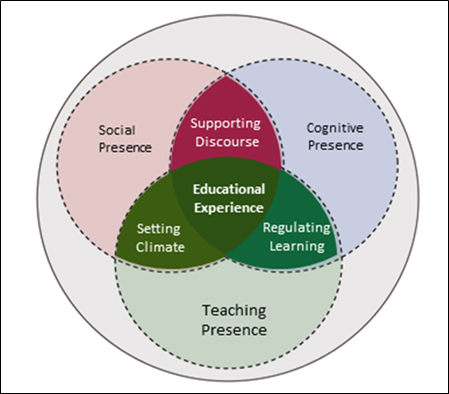
Figure 1: Community of Inquiry Framework (Garrison, 2017).
Image description available.
Recently, the focus in higher education has shifted from an individualistic to a more collaborative approach to learning (Kromydas, 2017). At the core of meaningfully engaged inquiry is the concept of metacognition, which is simply “thinking about one’s thinking” (Chick, 2013, Thinking about One’s Thinking section). Metacognition is key to learning how to learn. Metacognition means increasing awareness of the learning process and taking responsibility to control the learning process (Garrison, 2017). Metacognitive approaches to learning start with understanding and engaging where possible in the design and planning of the learning experience. Consistent with this, Garrison and Akyol (2015) have developed a shared metacognition construct, which is integral to the CoI framework (Garrison et al., 1999). Shared metacognition exists at the intersection of the cognitive and teaching presence constructs of the CoI framework and goes to the heart of a deep and meaningful educational learning experience (Figure 2).
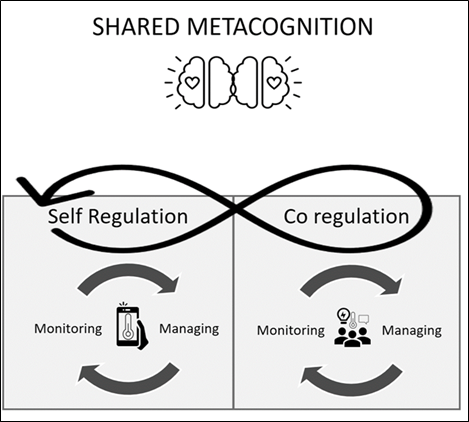
Figure 2: Shared Metacognition Construct (Vaughan et al., 2023)
Image description available.
Based on this shared metacognition construct, Vaughan et al. (2023) have developed seven principles to help guide the design, facilitation, and direction of online and blended courses and programs (Figure 3). These principles are derived from the teaching presence element of the CoI framework.
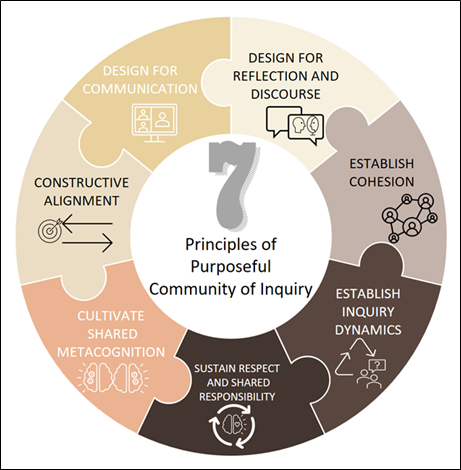
Figure 3: Seven Practical Principles of Blended Learning (Vaughan et al., 2023)
Image description available.
These seven principles have been further overlaid with Littky and Grabelle’s (2004) three (3) R’s of student engagement: relevance, relationships, and rigour. The following table illustrates the framework that was used to guide this research study (Table 1).
| Teaching Presence Category | 3 R’s of Engagement | 7 Principles of Online and Blended Learning |
|---|---|---|
| Design an Organisation | Relevance |
|
| Facilitation | Relationships |
|
| Direct Instruction | Rigour |
|
This study focused on an online module (course) on academic writing offered at the University of South Africa (UNISA). UNISA’s roots (and indeed that of higher education in South Africa) date back to 1873, when the University of the Cape of Good Hope was founded, initially functioning as an examining body for higher education. In 1916, the university changed its name to the University of South Africa and in 1918 it relocated to Pretoria. In 1946, it became one of the first public universities in the world to teach exclusively by means of distance education. Today, with more than 370,000 students, UNISA is the largest university in South Africa and on the African continent, and one of the world’s mega-universities (UNISA, 2024).
The ENGL 262: Applied English module was the focus for this study. This module is designed for Education students who will use English as the medium of instruction for learners in primary and middle school. The ultimate aim of this module is to enhance students’ proficiency in English so they can teach effectively and with confidence. This is a year-long module with approximately 1,200 second-year students enrolled in the course. The demographics of the students in this module span diverse racial groups, which include Black, White, Indian, Coloured, and Asian. Students in the module range in age from 18 to 70 years old. Most of the students registered in this course speak English as a first or additional language. Because UNISA services 132 countries, many of the registered students work part-time and live across South Africa and abroad. Some students have accessibility challenges to networks and technological devices. For this reason, many students end up completing assessments on their cell phones or travelling far distances to access an Internet cafe.
Our research is a case study design involving a self-study between two researchers in South African and Canadian Universities. The study is situated within the interpretivist paradigm following a qualitative approach. Although the interpretive paradigm is not yet a dominant research model, it is increasingly influential in qualitative research (Goldkuhl, 2012; Muzari et al., 2022; Thanh & Thanh, 2015) due to its ability to accommodate multiple perspectives and diverse truths (Alharahsheh & Pius, 2020; Pervin & Mokhtar, 2022; Thanh & Thanh, 2015). The paradigm and approach were well suited for the self-study type of research.
Aligned with key characteristics of self-study, our work is self-initiated (Hauge, 2021; LaBoskey, 2004) and involves reflecting on our personal and professional practice through ongoing and open dialogue (Samaras & Freese, 2009). This self-study involves two faculty members, one at UNISA and one at Mount Royal University. We worked as a pair of critical friends (Dinkelman, 2003; LaBoskey, 2004), meeting virtually on a regular basis to discuss the relationship between digital technologies and the seven principles of online and blended learning (Vaughan et al., 2023) to support collaborative learning practices at scale. Furthermore, as self-study should “not only be of significance to the person . . . conducting the study, but also of importance for creating meaning and contributing to increased understanding and knowledge for other teacher educators” (Hauge, 2021, p. 2), we are looking for implications beyond our own context and how other large-enrollment online courses might benefit from our research. Our data collection consists of critical dialogue, notes, and reflections from our virtual meetings (Guilfoyle et al., 2004) and our conversations with students enrolled in the applied English module (Fletcher et al., 2016).
Data was analysed using thematic analysis. Qualitative thematic analysis is defined by Hsieh and Shannon (2005) as “a research method for the subjective interpretation of the content of text data through the systematic classification process of coding and identifying themes or patterns” (p. 1278). Zhang and Wildemuth (2009) argue that thematic analysis emphasises an integrated view of texts and their specific contexts, which is essential when dealing with case study research. Content analysis also makes it manageable for more than one researcher to simultaneously work on the same data and ensure the quality of data analysis. Through systematic classification of data coding, key patterns in the data were discussed between the researchers (Lyons & LaBoskey, 2002). These are reported in the findings section.
We have used Vaughan et al.’s (2023) seven principles of online and blended learning to report our findings. As mentioned previously, these seven principles are derived from the teaching presence construct of the CoI (Garrison, 2017) framework that consists of the following three categories:
This category of teaching presence focuses on the design and organisation of a learning experience. The two principles associated with this category address the social and cognitive challenge of designing a collaborative blended learning experience. In terms of student engagement, Littky and Grabelle (2004) emphasise the importance of establishing relevance at the beginning of a course (the first R of engagement). They indicate that students should have a sense of curiosity and connectedness with the learning outcomes for the course.
Our findings highlight the importance of designing a module structure in a learning management system (LMS) that engages and motivates the students. For example, a thematic structure was developed in the Moodle platform for the applied English module to provide an inviting and intuitive navigation system (Figure 4).
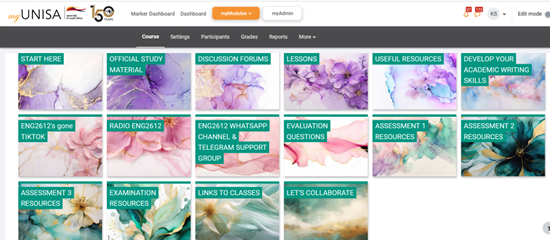
Figure 4: ENGL 262: Applied English Module Layout in Moodle
Image description available.
To help students develop a social and cognitive presence in a formal learning experience, it is important to allow students to provide personal introductions and set personal learning goals. This was achieved in this large enrollment module by creating discussion forums that enable students to share and comment on each other's personal introductions (Figure 5) and goals (Figure 6).
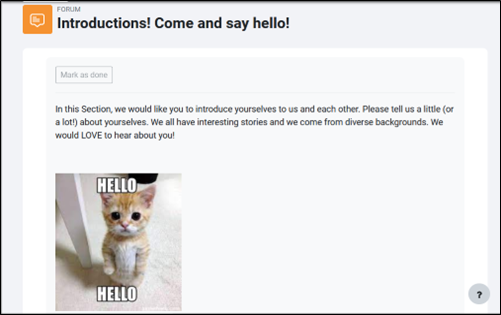
Figure 5: Introduction Discussion Forum
Image description available.
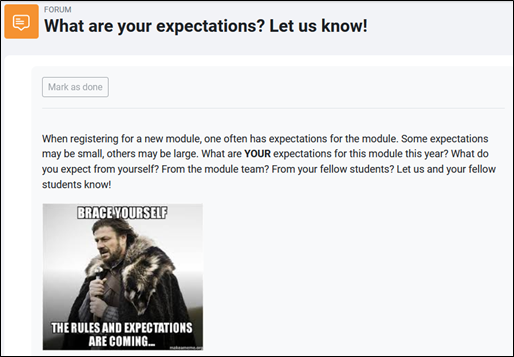
Figure 6: Personal Goals Discussion Forum
Image description available.
In addition to appreciating the module layout and discussion forums for sharing of introductions and goal setting, we discovered students appreciated the inclusion of TikTok videos for motivation and inspiration (Figure 7).
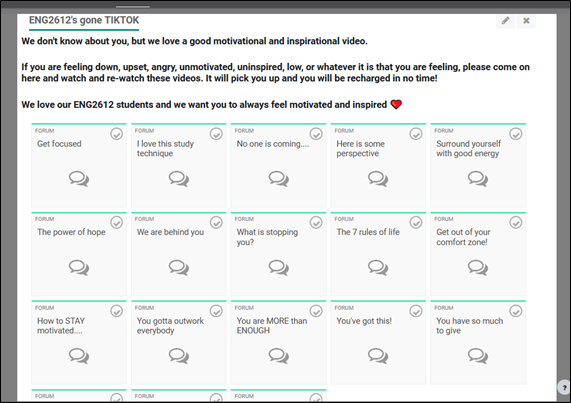
Figure 7: TikTok Videos
Image description available.
The second category of teaching presence is the concept of facilitation. This aligns with the two principles that address the social and cognitive concerns associated with facilitating a CoI, as well Littky and Grabelle’s (2004) second R of engagement, which focuses on relationships. Previous studies have demonstrated that creating a sense of community and collaboration in a module is key for helping students develop their capacity for shared metacognition and their professional identities (Vaughan et al., 2013).
Students in the applied English module emphasised that communication is key when it comes to facilitating a large enrollment online course, and they recommended the use of communication applications (channels) they are already familiar with and comfortable using. For example, Telegram (2024), which is similar to X (formerly Twitter) and WhatsApp (2024).

Figure 8: Communication Channels
Image description available.
The students also indicated the importance of facilitating course content in alternative modes, such as regular podcasts, throughout the duration of the module (Figure 9).

Figure 9: Module Podcasts
Image description available.
The final category of teaching presence is direct instruction, which is not about lecturing. Rather, direct instruction is about ensuring students achieve the intended learning outcomes of a course or program. Direct instruction is related to the fifth, sixth, and seventh principles of the CoI framework. It is an essential ingredient of any formal educational experience because it helps students learn how to learn by monitoring and managing their learning collaboratively (shared metacognition). It has been shown that students expect structure and leadership in higher education courses, and the roles and responsibilities for direct instruction should be shared by all members of a CoI, not only the course instructor (Garrison & Cleveland-Innes, 2005). This is congruent with Moore’s (1989) transactional theory, which describes and quantifies the instructor–student learning interaction in distance education.
The focus of direct instruction is on rigour (Littky & Grabelle, 2004), which is the third R of engagement. In a higher education course, this can involve students completing a challenging problem, task, or assignment that forces them to confront different perspectives and new ways of thinking. This process involves the teacher “nudging” the students forward in their academic studies (Thaler & Sunstein, 2008).
Providing direct instruction in a high-enrollment online course can be a particularly daunting task, and our experience suggests that it begins with explicit and extensive assignment support (Figure 10). For the applied English module, support for each assignment was provided via a podcast (including the written transcript), an optional web-based synchronous support session (with a link to the recording), as well as student and teacher feedback compiled from the first assignment.

Figure 10: Assignment Support
Image description available.
Again, in a CoI (Garrison, 2017), it is important to share the responsibility for direct instruction with the students. Thus, for each assignment in the applied English module as part of the assessment process, students were required to provide each other with peer feedback before submitting their assignments (Figure 11). In a previous study conducted by Vaughan (2013), students commented on the value of formative peer assessment activities. They indicated that the peer review process provided them with an opportunity to improve their work by learning with and from the other students in the course. The quotation, “to teach is to learn twice,” is attributed to the French moralist and essayist Joubert (1842). In an effective CoI, all participants are both students and teachers.

Figure 11: Assignment Peer Feedback and Support
Image description available.
Based on the findings from our self-study, we have created a series of recommendations for utilising Vaughan et al.’s (2023) seven principles of blended learning to design, facilitate, and direct a high-enrollment online module or course.
Our first recommendation is to acknowledge that learning does not happen instantly or overnight. This suggestion aligns with constructivist ideologies, which emphasise that knowledge is constructed gradually through active engagement and reflection. This gradual construction of knowledge is central to the CoI framework, where cognitive presence is developed through sustained reflection and critical discourse within a community (Garrison et al., 2001). Thus, it is important to design and scaffold learning activities that support the development of collaboration throughout the entire course, not just an icebreaker activity at the beginning (Carloni, 2023). Scaffolding is imperative because it allows students to progressively build on their knowledge and skills and facilitates deeper cognitive engagement over time. This approach is particularly critical in high-enrollment courses where diverse student backgrounds and different levels of prior knowledge can influence engagement and success. In the CoI framework, cognitive presence emphasises the phases of inquiry including triggering events, exploration, integration, and resolution, and this supports a scaffolded approach to learning (Garrison et al., 2001).
Secondly, a clear and consistent assignment structure in a LMS is essential. This structure should provide repetition and allow students to feed their learning forward from one assignment to the next. This concept of feeding forward aligns with the principles of formative assessment, where feedback from one task is used to inform and improve future tasks. Repetition and a consistent structure in the LMS help reduce cognitive load, which allows ENGL 262 students to focus more on content learning, rather than trying to get through the course. This is also in line with the design and organisation element of teaching presence in the CoI framework, which underlines the importance of a structured and well-organised course context that supports ongoing inquiry and learning (Garrison et al., 2024; Rehman et al., 2023).
Moreover, our findings suggest that the design of the course should not be static, but rather adaptable based on student feedback and engagement patterns. Boulton et al. (2019) found that student engagement fluctuates during the term, which indicates the need for a dynamic course design that can respond to these changes. This adaptive approach could involve interlinking elements such as regular check-ins, mid-course adjustments, and opportunities for students to reflect on their learning progress. Such an approach is supported by the relevance dimension of the CoI framework’s teaching presence, which advocates for designing learning experiences that are meaningful and connected to students’ interests and needs (Vaughan et al., 2023).
The integration of multimedia elements, such as TikTok videos, as found in our study, also supports engagement, which supports different learning preferences and enhances motivation. However, it is crucial to understand these elements not as simply add-ons, but as something meaningfully integrated into the course design to reinforce learning objectives and promote active and collaborative learning (Patino et al., 2023; Pavlov et al., 2021; Qureshi et al., 2023). This is consistent with the CoI’s principle of the creation of relevance in course content, which improves student engagement by connecting learning to real-world experiences and contemporary media (Vaughan et al., 2023).
Our experience suggests facilitating a high-enrollment module or course requires significant role adjustments for teachers in higher education. Lecturers must become facilitators of learning, rather than delivery vehicles of content. The shift from content delivery to facilitation corroborates with earlier studies, which emphasise the role of the teacher as a guide who supports students in constructing their own knowledge. This role is closely tied to the concept of teaching presence in the CoI framework, which involves facilitating discourse, supporting collaboration, and guiding the inquiry process (Garrison, 2017). Teachers must become more than a guide on the side or a sage on the stage. Teachers must model the “ways of thinking in their disciplinary or professional practice” (Prince, 2004; Vaughan et al., 2013, p. 46). It is crucial to model such disciplinary thinking to help students develop not only content knowledge, but also the critical thinking and problem-solving skills essential in their academic and professional lives. This practice is in line with the facilitation component of teaching presence, where teachers actively demonstrate and scaffold the intellectual practices specific to their field (Garrison et al., 1999). Of all the aspects of the CoI framework, the activities of facilitation are the most critical.
Facilitation monitors and manages the overlaps (setting climate, supporting discourse, and regulating learning) between the presences and is at the core of the dynamics of a CoI (see Figure 1). The CoI framework posits that facilitation is key to intertwining cognitive, social, and teaching presences because these elements create a cohesive and supportive learning environment (Garrison et al., 1999). Effective facilitation requires active involvement from the lecturer to create meaningful discourse, encourage collaboration, and support students in their learning processes (Huang & Lajoie, 2023; Pavlov et al., 2021). This is essential for building the social presence necessary for trust and open communication in a course, which are foundational to a successful online learning community (Garrison et al., 2024).
In the context of high-enrollment courses, facilitation can be challenging due to the scale and diversity of the student body. However, using technology, such as communication applications like Telegram and WhatsApp, as identified in our study, can help bridge this gap by providing platforms for ongoing interaction and community building (Baanqud et al., 2020). These tools can facilitate asynchronous discussions that enable students to engage with course content and each other in a flexible, low-pressure context that accommodates different learning styles and schedules. This approach supports the establishment of social presence, where students feel connected and supported in their learning journeys (Garrison, 2017).
Moreover, our findings suggest that the use of alternative modes of content delivery, such as podcasts, can enhance the facilitation process through diverse entry points for engagement. Podcasts allow course content to be disseminated in a format that is easily accessible and can be consumed at a student’s convenience, which supports the idea of collaborative and active learning. This corroborates with the facilitation component of teaching presence in the CoI framework to sustain student engagement and discourse (Garrison et al., 1999; Sevnarayan, 2023). However, it is important to note that facilitation is not only about using the right tools, but also about creating an inclusive and supportive learning environment. This means that we need to be responsive to student needs, providing timely feedback, and creating a sense of community where students feel comfortable sharing their ideas and engaging in critical discourse (Garrison, 2017; Ige et al., 2023).
The key insight for us from this study is that the teacher is the primary leader, but not the sole leader, when directing a CoI in a large enrollment online module. Similar to a captain’s responsibility for moving a ship forward, the teacher needs to encourage students to develop a growth mindset and move beyond their comfort zones (Dweck, 2006). This growth mindset is important to create and enhance resilience and a willingness to engage with challenging content, which is particularly important in the context of online distance learning, where students may feel isolated or overwhelmed. This also ties into the cognitive presence of the CoI framework, where students are encouraged to persist in their inquiry and engage deeply with course content (Garrison, 2017).
As with facilitation, there is a delicate balance with direct instruction. Too much or too little direction from the teacher will adversely affect the engagement of students and their willingness to assume metacognitively the responsibilities of teaching presence. This aligns with the concept of productive struggle, where students are given enough support to progress, but are also challenged to think critically and solve problems independently. The teacher’s role in this context is to provide guidance and feedback that helps students move through this struggle without becoming discouraged. This is supported by the teaching presence dimension of the CoI framework, where the teacher’s guidance is necessary to assist students to achieve meaningful learning outcomes (Garrison et al., 1999). Direction in a CoI is grounded in shared metacognition. That means being aware of intended goals and managing progression toward intended learning outcomes.
Shared metacognition involves both the teacher and students engaging actively in the process of monitoring and reflecting on learning. In large-enrollment courses, shared metacognition can be achieved through structured peer review activities, where students evaluate and provide feedback on each other’s work and develop their critical thinking and reflective skills (Vaughan, 2013). Participants in a learning community must not only be aware metacognitively of the process of inquiry, but also share thoughts regarding the positive development of collaborative inquiry. That is, students must be prepared to provide direction that will move the learning of their peers in a large enrollment online module.
Moreover, the findings of our study highlight the importance of providing explicit and extensive assignment support in high-enrollment courses. This support should include multiple forms of guidance, such as written instructions, video tutorials, and opportunities for synchronous and asynchronous interactions with the teacher. The use of peer feedback mechanisms, as implemented in our study, also play a crucial role in this process; this allows students to engage in constructive dialogue and learn from each other’s perspectives (Edumadze & Govender, 2024). These practices align with the rigour aspect of teaching presence in the CoI framework, which emphasises the need to uphold high academic standards while supporting student learning and engagement (Vaughan et al., 2023).
This study acknowledges some limitations that may affect the generalisability and interpretation of the findings. First, the study was conducted within one specific high-enrollment online module in a South African university, which may limit the applicability of the results to other contexts or educational contexts. We have relied on self-reported data from the LMS, which may affect the accuracy of student engagement and satisfaction measurements. In addition, the study focused on a particular set of technological tools and pedagogical strategies, and this may not fully capture the diversity of approaches or collaborative learning in different disciplines or institutions. Future research should address these limitations by exploring the influence of CoI on other large-enrollment courses in different contexts and disciplines.
Personally, this self-study has provided us with experience and insights about using Vaughan et al.’s (2023) seven principles of online and blended learning to design, facilitate, and direct collaborative learning activities in a high-enrollment online module. In terms of design, our key recommendation is to acknowledge that learning does not happen instantly or overnight. Thus, it is important to design and scaffold learning activities that support the development of collaboration throughout the entire course, not merely as an icebreaker activity at the beginning (Carloni, 2023).
With regards to facilitation, our study suggests that facilitating a high-enrollment module or course requires significant role adjustments for teachers in higher education. Teachers must become facilitators of learning, rather than delivery vehicles of content. The shift from content delivery to facilitation corroborates with earlier studies, which emphasise the role of the teacher as a guide who supports students in constructing their own knowledge.
For direct instruction, the key insight for us from this study is that the teacher is the primary leader but not sole leader when directing a CoI in a large-enrollment online module. Similar to a captain’s responsibility for moving a ship forward, the teacher needs to encourage students to develop a growth mindset and move beyond their comfort zones (Dweck, 2006).
Conversely, the main challenges we have encountered are the time, effort, and thought required for a teacher to successfully enact these design, facilitation, and direction principles with a large number of students.
We are encouraged by the recent work by Pratschke (2023) to incorporate the use of generative artificial intelligence (GenAI) applications to the CoI framework in a future study (Figure 12).
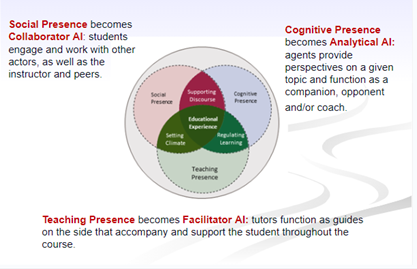
Figure 12: Generativism and Community of Inquiry
Image description available.
Pratschke (2024) has developed the term generativism to describe the symbiotic approach to teaching and learning with GenAI. Her work is aligned with the CoI (Garrison, 2017) framework and is grounded in the principle of learning as a process that employs constructivist and collaborative approaches to teaching. Pratschke (2024) states that co-designing with GenAI is the defining feature of generativism as a practice. Thus, knowledge can be generated in collaboration with GenAI, through learning activities that are co-designed, facilitated, directed, and assessed with GenAI. Pratschke (2023) has developed Figure 13 to describe how three categories of GenAI applications can be used to support the CoI framework.
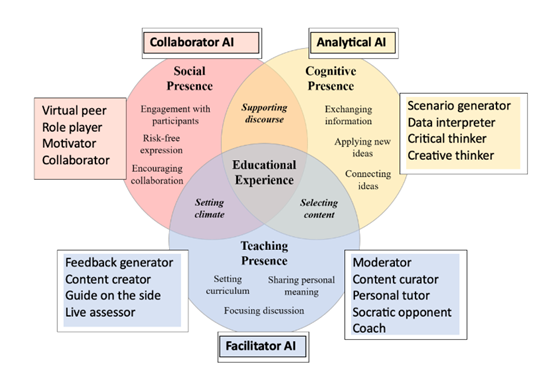
Figure 13: GenAI and Community of Inquiry (Pratschke, 2023)
Image description available.
For example, collaborator AI applications can be used to augment the social presence sphere by enabling role-playing and peer support activities for the students. In terms of cognitive presence, analytical AI applications can allow for scenario generation, data analytics, and critical thinking activities. In addition, facilitator AI applications can support and strengthen the sense of teaching presence in a high enrollment online course by providing scalable and efficient opportunities for peer feedback. The next stage of our research will involve evaluating the use of GenAI applications to support the design, facilitation, and direction of a CoI in the academic English module.
This work is based on the research supported in part by the National Research Foundation of South Africa (Ref Number SRUG2204285127).
Alharahsheh, H. H., & Pius, A. (2020). A review of key paradigms: positivism VS interpretivism. Global Academic Journal of Humanities and Social Sciences, 2(3), 39–43. https://gajrc.com/media/articles/GAJHSS_23_39-43_VMGJbOK.pdf
Baanqud, N. S., Al-Samarraie, H., Alzahrani, A. I., & Alfarraj, O. (2020). Engagement in web-supported collaborative learning and student knowledge construction: a modeling study. International Journal of Educational Technology in Higher Education, 17(56). https://doi.org/10.1186/s41239-020-00232-z
Boulton, C. A., Hughes, E., Kent, C., Smith, J. R., & Williams, H. T. P. (2019). Student engagement and wellbeing over time at a higher education institution. PLoS ONE, 14(11), e0225770. https://doi.org/10.1371/journal.pone.0225770
Carloni, G. (2023). Chapter 4: Transformative course design practices to develop inclusive online world language teacher education environments from a critical digital pedagogy perspective. In U. G. Singh, C. S. Nair, & S. Goncalves (Eds.), Digital Teaching, Learning and Assessment (pp. 65–77). Chandos Publishing. https://doi.org/10.1016/B978-0-323-95500-3.00007-9
Chan, A. K., Nickson, C. P., Rudolph, J. W., Lee, A., & Joynt, G. M. (2020). Social media for rapid knowledge dissemination: early experience from the COVID-19 pandemic. Anaesthesia, 75(12), 1579–1582. https://doi.org/10.1111/anae.15057
Chick, N. (2013). Metacognition. Vanderbilt University Center for Teaching. https://cft.vanderbilt.edu/guides-sub-pages/metacognition/
Department of Education. (2016, November). Advancing diversity and inclusion in higher education. Office of Planning, Evaluation and Policy Development, Office of the Under Secretary, U.S. Department of Education. https://www2.ed.gov/rschstat/research/pubs/advancing-diversity-inclusion.pdf
Dinkelman, T. (2003). Self-study in teacher education: a means and ends tool for promoting reflective teaching. Journal of Teacher Education, 54(1), 6–18. https://doi.org/10.1177/0022487102238654
Dweck, C. S. (2006). Mindset: The new psychology of success. Random House.
Edumadze, J. K. E., & Govender, D. W. (2024). The community of inquiry as a tool for measuring student engagement in blended massive open online courses (MOOCs): A case study of university students in a developing country. Smart Learning Environments, 11(19). https://doi.org/10.1186/s40561-024-00306-9
Fletcher, T., Nί Chrόinίn, D., & O’Sullivan, M. (2016). Multiple layers of interactivity in self-study of practice research: an empirically-based exploration of methodological issues. In D. Garbett, & A. Ovens (Eds.), Enacting self-study as methodology for professional inquiry (pp. 19–25). University of Auckland.
Forkosh-Baruch, A., & Hershkovitz, A. (2012, January). A case study of Israeli higher-education institutes sharing scholarly information with the community via social networks. Internet and Higher Education, 15(1), 58–68. https://www.learntechlib.org/p/53728/
Garrison, D. R. (2017). E-Learning in the 21st Century: A community of inquiry framework for research and practice (3rd Edition). Routledge: Taylor and Francis.
Garrison, D. R., & Akyol, Z. (2015, January). Toward the development of a metacognition construct for the communities of inquiry. Internet and Higher Education, 24, 66–71. https://doi.org/10.1016/j.iheduc.2014.10.001
Garrison, D. R., Anderson, T., & Archer, W. (1999). Critical inquiry in a text-based environment: computer conferencing in higher education. The Internet and Higher Education, 2(2-3), 87–105. https://doi.org/10.1016/S1096-7516(00)00016-6
Garrison, D. R., Anderson, T., & Archer, W. (2001). Critical thinking, cognitive presence, and computer conferencing in distance education. American Journal of Distance Education, 15(1), 7–23. https://doi.org/10.1080/08923640109527071
Garrison, D. R., & Cleveland-Innes, M. (2005). Facilitating cognitive presence in online learning: interaction is not enough. American Journal of Distance Education, 19(3), 133–148. http://dx.doi.org/10.1207/s15389286ajde1903_2
Garrison. D. R., Cleveland-Innes, M., & Vaughan, N. (2024). Community of Inquiry website. https://coi.athabascau.ca/
Goldkuhl, G. (2012). Pragmatism vs interpretivism in qualitative information systems research. European Journal of Information Systems, 21, 135–146. https://doi.org/10.1057/ejis.2011.54
Guilfoyle, K., Hamilton, M. L., Pinnegar, S., & Placier, P. (2004, January). The epistemological dimensions and dynamics of professional dialogue in self-study. In J. J. Loughran, M. L. Hamilton, V. K. Laboskey, & T. Russell (Eds.), International handbook of self-study of teaching and teacher education practices (pp. 1109–1167). http://dx.doi.org/10.1007/978-1-4020-6545-3_28
Hamann, K., Glazier, R., Wilson, B., & Pollock, P. (2020, July 30). Online teaching, student success, and retention in political science courses. European Political Science, 20, 427–439. https://doi.org/10.1057/s41304-020-00282-x
Hauge, K. (2021). Self-study research: Challenges and opportunities in teacher education. In M. J. Hernandez-Serrano (Ed.), Teacher education in the 21st century – emerging skills for a changing world (pp. 139–156). IntechOpen. https://doi.org/10.5772/intechopen.96252
Hsieh, H.-F., & Shannon, S. E. (2005). Three approaches to qualitative content analysis. Qualitative Health Research, 15(9), 1277–1288. https://doi.org/10.1177/1049732305276687
Huang, X., & Lajoie, S. P. (2023). Social emotional interaction in collaborative learning: why it matters and how can we measure it? Social Sciences & Humanities Open, 7(1), 100447. https://doi.org/10.1016/j.ssaho.2023.100447
Ige, B. O., Doyle, G., & Pienaar, L. (2023). Partnering with students to connect students. South African Journal of Higher Education, 37(4), 163–80. https://doi.org/10.20853/37-4-5074
Joubert, J. (1842). Pensees. https://archive.org/details/pensesdcompl00joubuoft/page/n7/mode/2up
Kromydas, T. (2017). Rethinking higher education and its relationship with social inequalities: past knowledge, present state and future potential. Palgrave Communications, 3(1). https://www.nature.com/articles/s41599-017-0001-8#citeas
LaBoskey, V. K. (2004). The methodology of self-study and its theoretical underpinnings. In J. J. Loughran, M. L. Hamilton, V. K. LaBoskey, & T. Russell (Eds.), International handbook of self-study of teaching and teacher education practices (pp. 817–869). Springer. https://doi.org/10.1007/978-1-4020-6545-3_21
Lei, M., & Medwell, J. (2021). Impact of the COVID-19 pandemic on student teachers: how the shift to online collaborative learning affects student teachers’ learning and future teaching in a Chinese context. Asia Pacific Education Review, 22, 169–179. https://doi.org/10.1007/s12564-021-09686-w
Littky, D., & Grabelle, S. (2004). The big picture: education is everyone’s business. Association for Supervision and Curriculum Development.
Lyons, N., & LaBoskey, V. K. (2002). Why narrative inquiry or exemplars for a scholarship of teaching? In N. Lyons, & V. K. LaBoskey (Eds.), Narrative inquiry in practice: advancing the knowledge of teaching (pp. 11–27). Teachers College Press.
Michalski, J. H., Cunningham, T., & Henry, J. (2017). The diversity challenge for higher education in Canada: the prospects and challenges of increased access and student access. Humboldt Journal of Social Relations, 39(39), 66–89. https://www.jstor.org/stable/90007872
Moore, M. G. (1989). Editorial: Three types of interaction. American Journal of Distance Education, 3(2), 1–7. https://eddl.tru.ca/wp-content/uploads/2019/08/EDDL5101_W9_Moore_1989.pdf
Muzari, T., Shava, G. N., & Shonhiwa, S. (2022). Qualitative research paradigm, a key research design for educational researchers, processes and procedures: a theoretical overview. Indiana Journal of Humanities and Social Sciences, 3(1), 14–20. https://indianapublications.com/articles/IJHSS_3(1)_14-20_61f38990115064.95135470.pdf
Panitz, T. (1999, December). Collaborative versus cooperative learning: a comparison of the two concepts which will help us understand the underlying nature of interactive learning. https://files.eric.ed.gov/fulltext/ED448443.pdf
Patiño, A., Ramírez-Montoya, M. S., & Buenestado-Fernández, M. (2023). Active learning and education 4.0 for complex thinking training: analysis of two case studies in open education. Smart Learning Environments, 10(8). https://doi.org/10.1186/s40561-023-00229-x
Pavlov, V., Smirnova, N. V., & Nuzhnaia, E. (2021). Beyond the avatar: using video cameras to achieve effective collaboration in an online second language classroom. Journal of University Teaching & Learning Practice, 18(7), 228–243. https://doi.org/10.53761/1.18.7.14
Pazzaglia, A. M., Clements, M., Lavigne, H. J., & Stafford, E. T. (2016). An analysis of student engagement patterns and online course outcomes in Wisconsin. National Center for Education Evaluation and Regional Assistance. https://files.eric.ed.gov/fulltext/ED566960.pdf
Pervin, N., & Mokhtar, M. (2022). The interpretivist research paradigm: a subjective notion of a social context. International Journal of Academic Research in Progressive Education and Development, 11(2), 419–428. http://dx.doi.org/10.6007/IJARPED/v11-i2/12938
Pratschke, B. M. (2023). Generativism: the new hybrid. Computers and Society, (cs.CY). https://doi.org/10.48550/arXiv.2309.12468
Pratschke, B. M. (2024). Generative AI and education: digital pedagogies, teaching innovation, and learning design. Springer.
Prince, M. (2004). Does active learning work? A review of the literature. Journal of Engineering Education, 93(3), 223–231. https://doi.org/10.1002/j.2168-9830.2004.tb00809.x
Quality Matters. (2024). Changing landscape of online education (chloe) strategy shift: institutions respond to sustained online demand. https://www.qualitymatters.org/qa-resources/resource-center/articles-resources/CHLOE-9-report-2024
Qureshi, M. A., Khaskheli, A., Qureshi, J. A., Raza, S. A., & Yousufi, S. Q. (2023). Factors affecting students’ learning performance through collaborative learning and engagement. Interactive Learning Environments, 31(4), 2371–2391. https://doi.org/10.1080/10494820.2021.1884886
Rehman, M. A., Lashari, A. A., & Abbas, S. (2023). Analysis of sustainable academic performance through interactive learning environment in higher education. Global Economics Review, VIII(II), 129–139. https://doi.org/10.31703/ger.2023(VIII-II).10
Resta, P., & Shonfeld, M. (2013). A study of trans-national learning teams in a virtual world. In R. McBride, & M. Searson (Eds.), Proceedings of the Society For Information Technology and Teacher Education International Conference 2013 (pp. 2932–2940). Chesapeake, VA: AACE.
Samaras, A. P., & Freese, A. R. (2009). Looking back and looking forward: a historical overview of the self-study school. In C. A. Lassonde, & S. Galman (Eds.), Self-study research methodologies for teacher educators (pp. 3–19). Brill Publishers.
Sevnarayan, K. (2023). The implementation of telegram as a pedagogical tool to enhance student motivation and interaction. Journal of Education Technology, 7(1), 71–79. https://doi.org/10.23887/jet.v7i1.52488
Telegram. (2024). Telegram messenger. https://telegram.org/
Thaler, R., & Sunstein, C. (2008). Nudge. Penguin Books.
Thanh, N. C., & Thanh, T. T. (2015). The interconnection between interpretivist paradigm and qualitative methods in education. American Journal of Educational Science, 1(2), 24–27.
UNISA. (2024). National treasure with a global reach. https://www.unisa.ac.za/sites/corporate/default/About/The-leading-ODL-university
Vaughan, N. D. (2013). Investigating how digital technologies can support a triad-approach for student assessment in higher education. Canadian Journal of Learning and Technology, 39(3), 1–22. https://doi.org/10.21432/T2RG6X
Vaughan, N. D., Cleveland-Innes, M., & Garrison, D. R. (2013). Teaching in blended learning environments: creating and sustaining communities of inquiry. Athabasca University Press. https://doi.org/10.15215/aupress/9781927356470.01
Vaughan, N. D., Dell, D., Cleveland-Innes, M., & Garrison, D. R. (2023). Principles of blended learning: shared metacognition and communities of inquiry. Athabasca University Press. https://doi.org/10.15215/aupress/9781771993920.01
WhatsApp. (2024). WhatsApp. https://web.whatsapp.com/
Xing, W., Zhu, G., Arslan, O., Shim, J., & Popov, V. (2023). Using learning analytics to explore the multifaceted engagement in collaborative learning. Journal of Computing in Higher Education, 35(3), 633–662. https://doi.org/10.1007/s12528-022-09343-0
Xu, B., Stephens, J. M., & Lee, K. (2024). Assessing student engagement in collaborative learning: development and validation of new measure in China. The Asia-Pacific Education Researcher, 33, 395–405. https://doi.org/10.1007/s40299-023-00737-x
Zhang, Y., & Wildemuth, B. M. (2009). Qualitative analysis of content. In B. M. Wildemuth (Ed.), Applications of social research methods to questions in information and library science (pp. 318–329). https://www.drghazi.net/media/drghazi/documentary8.pdf
Kershnee Sevnarayan obtained her PhD from the University of Kwa-Zulu Natal, South Africa. She has 14 years of teaching experience. She is an Associate Professor in the Department of English Studies at the University of South Africa. She is also a Shanghai Open University visiting scholar. She is a recipient of the National Research Foundation grant in South Africa. She is currently supervising Master’s and Doctoral candidates and has published her works in internationally accredited journals. Her research interests include open distance e-learning, technology-mediated teaching, artificial intelligence, learning, and pedagogy in higher education.
Norman Vaughan, PhD, is a Professor in the Department of Education at Mount Royal University in Calgary, Alberta, Canada. He has co-authored the books Principles of Blended Learning: Shared Metacognition and Communities of Inquiry (2023), Teaching in Blended Learning Environments: Creating and Sustaining Communities of Inquiry (2013), and Blended Learning in Higher Education (2008). In addition, he has published a series of articles on blended learning and teacher development. Dr. Vaughan is the Co-founder of the Blended Online Design Network (BOLD), a founding member of the Community of Inquiry Research Group, the Associate Editor of the International Journal of Mobile and Blended Learning, and he is on the Editorial Boards of numerous national and international journals.
Figure 1 Image Description: A Venn diagram of the CoI framework with overlapping circles for social presence, cognitive presence, and teaching presence:
Figure 2 Image Description: Illustrates shared metacognition as consisting of self-regulation and co-regulation, both of which entail a cycle of monitoring and managing.
Figure 3 Image Description: Illustrates the seven principles of purposeful Community of Inquiry as puzzle pieces on a wheel that include:
Figure 4 Image Description: Screen capture of the main ENGL 262 webpage in MOODLE. Includes links to Start Here, Official Study Material, Discussion Forums, Lesson, Useful Resources, etc.
Figure 5 Image Description: Screen capture of the ENGL 262 webpage for the Introductions Discussion Forum.
Figure 6 Image Description: Screen capture of the ENGL 262 webpage for the Personal Goals Discussion Forum.
Figure 7 Image Description: Screen capture of the ENGL 262 webpage of TikTok videos for inspiration and motivation.
Figure 8 Image Description: Screen capture of the ENGL 262 webpage that links to the Telegram social media group for the course.
Figure 9 Image Description: Screen capture of the ENGL 262 webpage that links to podcasts for the course.
Figure 10 Image Description: Screen capture of the ENGL 262 webpage that shows assignment support, including the podcast transcript, live-stream session recording, and feedback.
Figure 11 Image Description: Screen capture of the ENGL 262 webpage for students to give each other peer feedback and collaborate.
Figure 12 Image Description: Builds on the Venn diagram of social presence, cognitive presence, and teaching presence provided in Figure 1 Image Description by explaining that:
Figure 13 Image Description: Builds on the Venn diagram of social presence, cognitive presence, and teaching presence provided in Figure 12 Image Description by summarizing: